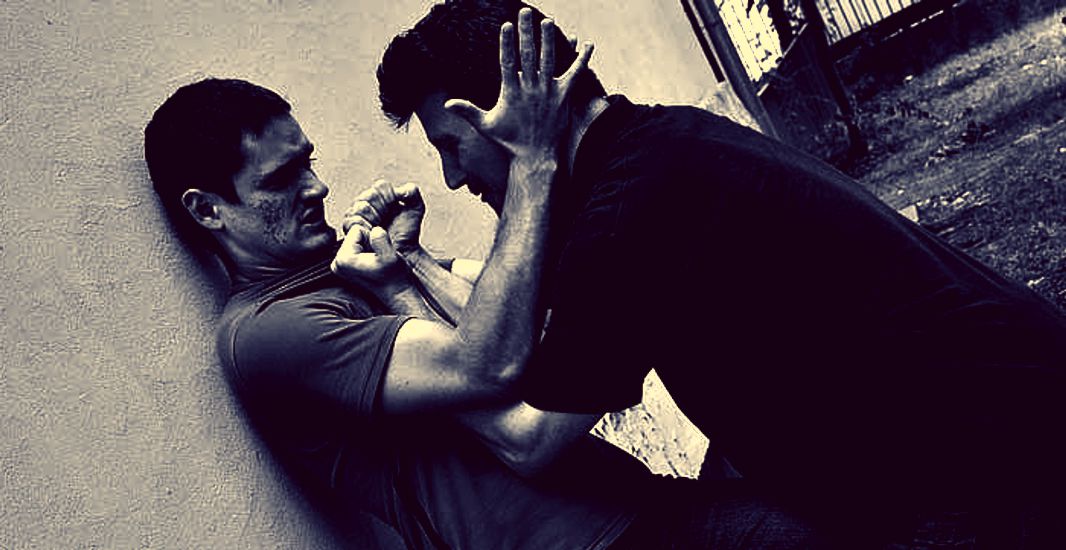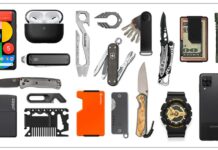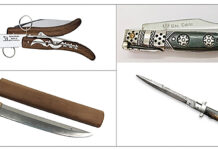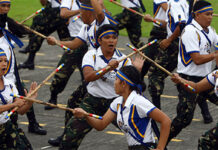Here’s a shocker for you … martial arts are about survival. Yep, that’s right. The purpose of martial arts is to have the skill and knowledge to be able to do in the bad guy and still make it home in time to walk the dog. Martial arts are not some trendy type of workout designed to impress the ladies as you tell them about the tournaments or trophies you’ve won. While it certainly is an awesome total-body workout and a great way to get in shape many students really give little thought to its ultimate purpose; survival.
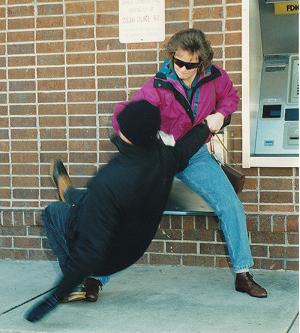 Let’s talk self-defense. I was one of the co-founders of the United Karate Institute of Self-Defense, Inc. in Alexandria, Virginia. Three other instructors, my wife (also a black belt) and I decided that we had met way too many highly ranked black belts who had earned numerous trophies in sport karate competition. They were champions and winners and knew all the tricks in the ring to be able to score points and come home with the large gleaming plastic and marble trophies. Sounds great doesn’t it. Except for one small problem, virtually every one of these black belt “champions” did not possess even the most basic skills or knowledge of how to defend themselves against even a single assailant, much less multiple assailants. What’s up with that?
Let’s talk self-defense. I was one of the co-founders of the United Karate Institute of Self-Defense, Inc. in Alexandria, Virginia. Three other instructors, my wife (also a black belt) and I decided that we had met way too many highly ranked black belts who had earned numerous trophies in sport karate competition. They were champions and winners and knew all the tricks in the ring to be able to score points and come home with the large gleaming plastic and marble trophies. Sounds great doesn’t it. Except for one small problem, virtually every one of these black belt “champions” did not possess even the most basic skills or knowledge of how to defend themselves against even a single assailant, much less multiple assailants. What’s up with that?
They’re black belts. They should be able to leap over tall buildings, outrun bullets, stop a speeding train and run between the raindrops! Right? No, but it certainly seems to the average person that a black belt must be nearly indestructible and probably possesses some almost mystical power and knowledge. Wrong again. If you are not trained properly with a real emphasis on self-defense and street application of martial arts techniques then you are merely mimicking movements from your instructor.
If you’re a black belt and you can’t even defend your way out of a wet paper bag then what have you spent all of those years doing? Let me say it again, martial arts are about survival. It’s not about phony point-sparring competition where the only techniques you can use in the ring are things you would never dream of using on the street and where the most effective techniques from the street are not allowed in the ring.
When you study martial arts it’s not all just punching and kicking, you must learn about many qualities of humanity, both positive and negative because your brain is your ultimate survival tool. Ultimately, at its core, is the need to survive; be it on the streets of New York City, the jungles of Asia, the deserts of the Middle East or even a hostile business climate. To survive combat and harsh environments, you the martial artist must have many skills and have developed many physical and character qualities. In order to survive, you must improve yourself beyond your current abilities. However, remember the best warrior is not warlike, but is able to summon the warrior spirit within when it is required.
Preparing to Survive: Adaptability and Versatility
Survival requires adaptability, which is the ability to respond rapidly, effectively and without confusion to changing stimuli. These stimuli can be different training conditions. They can be new techniques, styles of martial arts, weapons or changes in lighting, temperature, speed, distance, surface, or any other attribute of your environment.
To survive, welcome change by varying your training. The more you do this, the better equipped you are to adapt effectively, because you are always doing it. Many martial arts systems have training sessions where their students practice their martial arts in the rain, snow, mud, swamps and other rough and difficult terrain. In this manner students learn to be aware of environmental factors, but also filter out distractions and focus on defeating their opponent.
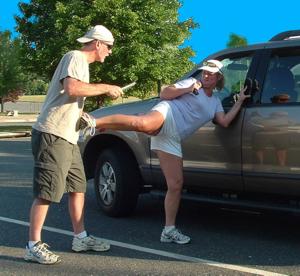 Do not become frustrated as circumstances change or vary. Welcome this. Anything else would be boring. Variety improves and maintains your survival skills. You cannot possibly adapt if you are not first aware of what is around you to which you can learn to adapt. If you can adapt, you may just survive.
Do not become frustrated as circumstances change or vary. Welcome this. Anything else would be boring. Variety improves and maintains your survival skills. You cannot possibly adapt if you are not first aware of what is around you to which you can learn to adapt. If you can adapt, you may just survive.
Adaptability can also refer to using your environment. For example, you may use your environment by grabbing a handful of sand to throw in your opponent’s eyes. You may grab a branch lying on the ground to strike your opponent or shove them headfirst into a vertical pole support inside a subway car or city bus. These are examples of using features of the terrain or surrounding environment to your advantage to augment your martial techniques. Typically, these are weapons of opportunity.
Versatility is having a broad range of skills; you can kick well, punch well, move well, think well etc. Versatility is the quality of having many skills; adaptability is the ability to acquire new skills readily. As you become more versatile, you will gradually become more adaptable. Do not confuse these two and train appropriately.
Realism and Diversity in Training
The more realistic the training experience . . . the less shocking reality will seem. Part of varying your training is practicing for realism. Take your training seriously. If it is a joke or becomes too much of a social gathering, you will be easily surprised or overwhelmed in a real situation. As I described earlier, some schools of martial arts practice in swamps, rain, and all types of terrain and environments. Martial arts are a war fighting skill where realism is a key ingredient.
Part of the reason for the diversity and variation in training is to introduce different realistic elements. A curious thing happens when you make a training drill very realistic, you become uncomfortable. Reality isn’t always pleasant, but reality is what you are training for. Being uncomfortable is a good thing. Get used to it in training so that you will not be surprised if it happens for real.
In a real fight, try not to ever let your opponent see that you are injured. Play off your injury if possible. Even if your injury is visible or noticeable, let your opponent think that it is not affecting you. This will make him stop and think that maybe his techniques are ineffective. In other situations, depending upon the opponent and the circumstances you may want to pretend that you are injured worse than you are. Pretending a more serious injury can give your opponent a false sense of security thinking that he is close to defeating you. Then you will have him. This is deception at its best. It also helps not to focus on yourself. Keep your eyes and your mind on your opponent in a real fight. Injuries can be dealt with later; a real opponent must be dealt with immediately.
Probing: Preparing to Attacking
Whether your opponent is an army of one-hundred-thousand men or a single man, you must probe to find weaknesses and collect information about your opponent’s strength, position, mobility, reactions and skill.
Attack your enemy where they are weak, but first know this by probing. Test for weaknesses. Watch closely and observe potential weakness, signs of inexperience or disorganization. If you feint an attack and your enemy does not respond in a way that is adequate for his own defense, then you have discovered a potential weakness or area where you may be able to make an opening.
When you probe your opponent in a particular way, not only make a note of what their response was, but how fast, precise and strong their response was. These factors will be important in determining how to attack and how to construct and time your attack.
Deception: The Key to Victory
Sun Tzu said that deception is the key to victory in all warfare, but what is deception? If I am to apply it, I must know what it is and how to apply it. What constitutes deception? Creativity is the key to deception. Think of ways to draw your opponent off their guard. When they are expecting one thing, give them something else. Draw their attention away from your true intentions so that when your true intentions are realized, your opponent will be caught unprepared and surprised. Do not be predictable.
The components of deception are these:
- Creativity
- Feinting or Faking
- Distraction
- Opposites
These components combined intelligently give you the basis of a strategy. You must practice your creativity. Creativity means developing new and different ways of feinting and methods of distraction or the use of opposites.
You must always create or switch to new means of deception because once your opponent recognizes a deceptive tactic, no matter how elusive or cunning, he will be better prepared to counter it. Always give him something new to deal with. This will give you the advantage.
Distraction is not the same as faking. When you fake, you make your opponent think one thing is happening when it is not. Distraction gives your opponent something to focus on or deal with while you follow up with your true intentions. The idea is that by the time you follow up with your true intentions, your opponent is still too busy dealing with what preceded them.
The difference between a distraction and a fake is that with a distraction you actually are doing something; with a fake, you are only making your opponent think that you are doing something. This applies to combat, self-defense and many things.
Distractions are not necessarily always physical movements. They may be psychological also. You may distract an attacker who is intent upon doing you harm by talking to him. You may use psychology to distract him and engage him in a conversation, which is actually buying you time to size up the situation better or to maneuver to a more advantageous position.
If you are able to engage your opponent’s mind and distract him that way, then you may not have to rely upon physical skill and posturing. Consider the possibilities. This is how hostage negotiators prevent unwanted physical harm from occurring.
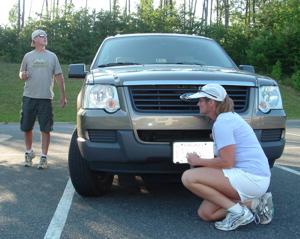 Fakes must look real or they will not work. A bad fake is worse than no fake because you leave yourself vulnerable. The advantage of a believable fake is that if the opponent does not react in time you may just use the fake for real. To make a fake look real, you must believe that you are actually going to do whatever it is. Then at the last instant, do not do it, pull the technique short and instantly follow it up with the technique you really intended.
Fakes must look real or they will not work. A bad fake is worse than no fake because you leave yourself vulnerable. The advantage of a believable fake is that if the opponent does not react in time you may just use the fake for real. To make a fake look real, you must believe that you are actually going to do whatever it is. Then at the last instant, do not do it, pull the technique short and instantly follow it up with the technique you really intended.
The purpose of a fake is to make your opponent react to it, generally to create an opening that you can take advantage of with a different technique. For example, a fake kick toward the head might make your opponent raise both arms to guard their face and head. This exposes their torso where you may actually be planning to land a punch.
Whatever technique you choose to fake, the two key elements of an effective fake are that the fake technique must look completely real – especially against an experienced martial artist – and the follow up after the fake must be fast and decisive in order to take advantage of the opening or opportunity that you have created.
Attacking
As I have said, attack your opponent’s weaknesses. Of course, you must first discover his weaknesses by probing. Once you have found these, attack them relentlessly. Do no attack him when he is strong or ready, hold off on this or you will be wasting effort.
Attacks can take a variety of forms. They may be like pecking away occasionally to annoy your opponent and gradually wear him down. It could be that his biggest weakness is simply endurance or stamina. You may simply float around him pecking occasionally until he cannot continue. Then either finish him off or leave.
An attack can be a short concentrated burst and then it is over. You can use a short burst to distract and disorient your opponent, putting them at a disadvantage, then follow up with the main body of the attack and finish with the grand finale to secure a final victory.
Another critical concept for you to grasp is that in a self-defense situation your survival may depend upon striking first. At the corps of this concept is a philosophy espoused by Bruce Lee. If you feel that an assault or attack is imminent when you find yourself in a perilous situation and you are convinced that your safety or life is in grave danger – strike first. The pre-emptive strike may give you edge you need to survive. On the street and in combat, there are no extra courtesy points for allowing your assailant to throw the first strike.
Decisiveness
Do not hesitate. Wait, be prepared, time your technique and strike, but do not hesitate. Take the advantage before your opponent seizes it. Decisiveness is essential in survival situations so that you may pre-empt your opponent. Pre-emption is necessary when you sense or read your opponent and determine that they are about to strike or position themselves in some way that increases the threat they pose to you. Be decisive on a course of action to prevent your opponent from realizing his plans.
Recycling Your Weapons
Do not allow an opponent to use a weapon (gun/knife/arm/leg) again after you have disarmed them. Stepping on the weapon, tossing, or kicking it away prevents recycling. However, you do want to recycle your own weapons and reuse them as often as is appropriate – circular strikes can be easily repeated, modified and used repeatedly and combined with hip rotation for added power. If you grab an arm or wrist or foot – do not let go. These are weapons. If you have one, damage it or control it so that your opponent cannot use it against you again.
Damaging their Weapons
Punch the arm or block the arm that is punching to hurt the arm or wrist. Damage the knee, foot, or leg so that it cannot be used to kick again. If the situation is serious, break the wrist, shoulder, elbow, or fingers so that they cannot be used again to hurt you! You must decide what is appropriate based on the level of threat.
Environment and Terrain as Strategy
The things around you make up your environment. This includes the terrain, the surfaces covering the terrain, objects, artifacts, obstructions, structures and people around you.
Your environment can be used to your advantage. It can also be used to your opponent’s advantage. Beware of this. The ways in which environment can be used are many. You may be able to hide or escape from an opponent in the dark or fog. You may be able to use everyday objects around you as weapons to add to your empty-handed defense.
You can use a wall or a railing to push off or as a support for throwing a kick to make you more stable and less vulnerable. You can throw objects in the path or the face of your attacker to distract him and buy you time to maneuver or escape.
You can use nearly any object around you to throw, swing, tip, spray or move rapidly and easily to put time or distance between you and your opponent. Consider the possibilities often and you will be surprised what you find that you had never noticed. However, do not get too caught up in a desperate self-defense situation trying to find too many objects or obstructions that may actually slow you down more than they do your opponent.
Whenever using weapons of opportunity or aspects of your environment they must be readily accessible and useable, only requiring a split second to grab or put to use to aid your defense or to provide some momentary advantage. Anything more will actually put you at a disadvantage.
You can train, study and prepare, but if when you are in a self-defense situation or any other form of combat, you do not have a grasp of the terrain and its surfaces, then you may be surprised and defeated.
It is essential to vary your training. This includes varying the type of terrain or surfaces upon which you train. Your training should give you the opportunity to train on grass, dirt, gravel, in the water or mud and on smooth surfaces such as ice or tiles. All of these surfaces require you to adapt and select different techniques and strategies from your library.
Terrain is not merely the surfaces of the ground upon which you stand, but the contours of the ground beneath these surfaces. As Sun Tzu said, terrain can have many characteristics, which can give the advantage or take away an advantage.
Terrain can provide an escape route such as in wide-open areas. Another escape route may be a wooded area or a maze of alleys where you may give your opponent the slip. You can use terrain as a vantage point, such as at higher elevations. You can use it to encircle or otherwise entrap an opponent. You can use terrain to conceal and protect. This may be good for you or bad for you depending upon whether you are the one concealing yourself or whether your enemy is concealing himself.
Any surface or terrain where your footing or balance is compromised or put at a disadvantage will require you to either grab hold of some handle or railing to stay upright or you will have to lower your center of gravity and your stance to keep from falling.
Use the terrain or objects around you to your advantage. Rocks and boulders offer a shield, concealment or protection. You can kick up loose dirt or throw it in your opponent’s face. You may also do this with water or other liquids.
If some other surface is so unpredictable or disadvantageous that you cannot maintain balance and control, you may even consider drawing your opponent to the ground and taking the conflict lower, providing that you have trained and studied ground fighting. Then you will have an advantage even on disadvantageous terrain.
You can use icy, snowy surfaces for a ground fight, and then you will not be so concerned with maintaining your balance or footing because you are already down. If you choose to stay upright, then you must widen your stance to be more flat-footed to maintain traction. Kicks and sweeps are more risky because they reduce your stable base. In these cases, hand techniques may be more appropriate. Your techniques and strategy will vary with the terrain and the surfaces. Find advantages where there appear to be none. This is the essence of victory!
Also, be aware the same advantages you may find, your enemy can use. Do not assume that your opponent will not use the terrain or surfaces to the same advantage that you would. You must train on different terrains, flat, uneven, hilly, rocks, wooded, cluttered with debris or rubble, in narrow confines such as alleys or elevators, in wide-open places and in streams or inside automobiles or moving trains.
Terrain is a large component of the environment, as I have discussed. The more often you train in different terrains and environments, the more versatile and adaptable you can become.
It’s About Survival
I started out by saying that martial arts are about survival. The topics I have covered in this article only provide a brief glimpse into a few key concepts that for most commercially educated martial artists are completely foreign. I encourage you to study combat techniques and tactics for urban combat and street assaults and to incorporate what you learn into your training. Check out books and videos to gain a better understanding of these tactics and study how techniques you have learned in your martial arts training can be incorporated or adapted for practical use in a real situation rather than just as a form of demonstration for your next belt test.
We had a saying at United Karate … “If you can’t defend yourself … nothing else matters.”

